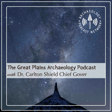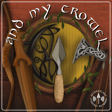
Animals of the Great Plains - Ep 02
In this episode of the Great Plains Archaeology Podcast, host Carlton Shield Chief Gover takes you on a journey through the diverse and fascinating world of the animals that have roamed the Great Plains for thousands of years. From mighty bison herds to elusive prairie dogs, the animals of the Plains have played an essential role in the lives of Indigenous peoples, shaping their cultures, diets, and spiritual practices. We'll explore how these creatures have influenced the archaeological record, offering clues to past lifeways and helping us better understand the deep connection between humans and the natural world. This episode also highlights the significance of key species in Plains ecology and their impact on the landscape.
Youtube: https://youtu.be/llKpPcN1z20
Links:
- Organization of bison hunting at the Pleistocene/Holocene transition on the Plains of North America by KC Carlson & Leland Bement (2013)
- American Serengeti: The Last Big Animals of the Great Plains by Dan Flores (2016)
- The Archaeology of the North American Great Plains by Douglas B. Bamforth (2021)
- Archaeology on the Great Plains Edited by W. Raymond Wood (1998)
- Carlton's KU Anthropology Faculty Bio
Transcripts
- For rough transcripts of this episode, go to: https://www.archpodnet.com/great-plains-archaeology/02
Contact:
- Instagram: @pawnee_archaeologist
- Email: greatplainsarchpodcast@gmail.com
Affiliates



